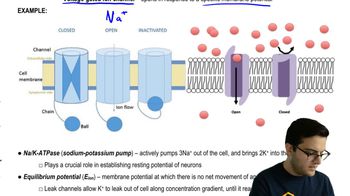Here are the essential concepts you must grasp in order to answer the question correctly.
Sodium-Potassium Pump
The sodium-potassium pump is a vital membrane protein that uses ATP to transport sodium ions out of the cell and potassium ions into the cell, maintaining essential concentration gradients. This active transport mechanism is crucial for various cellular functions, including nerve impulse transmission and muscle contraction.
Recommended video:
Concentration Gradient
A concentration gradient refers to the difference in the concentration of a substance across a space or a membrane. In cells, gradients are essential for processes like diffusion and active transport, where substances move from areas of high concentration to low concentration, or vice versa, often requiring energy input.
Recommended video:
Concentration Gradients and Diffusion
ATP Utilization in Active Transport
ATP (adenosine triphosphate) is the energy currency of the cell, used in active transport to move substances against their concentration gradients. The sodium-potassium pump specifically uses ATP to change its conformation, allowing it to transport sodium and potassium ions across the cell membrane, crucial for maintaining cellular homeostasis.
Recommended video:






